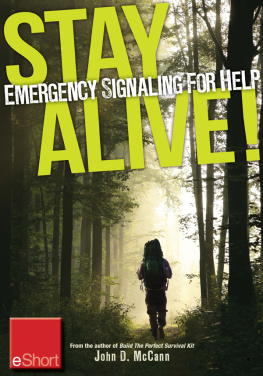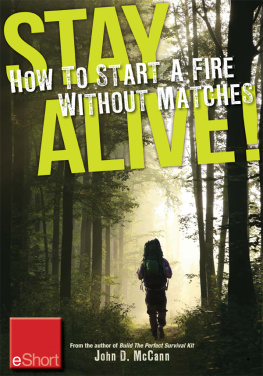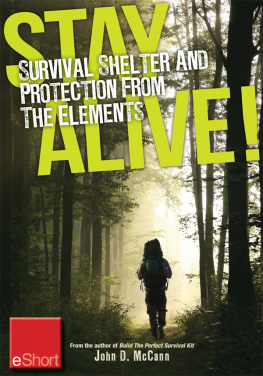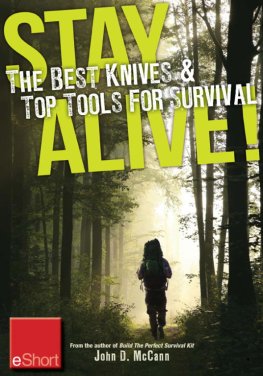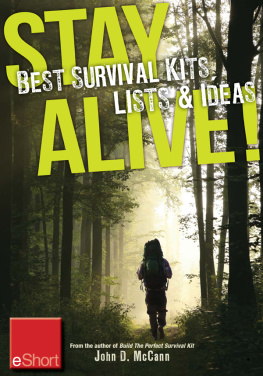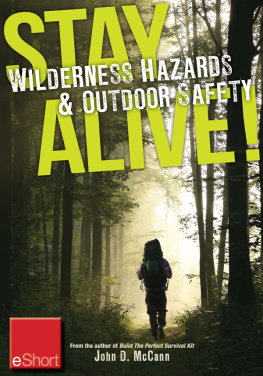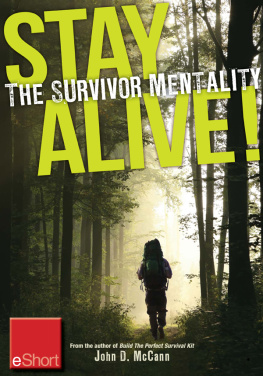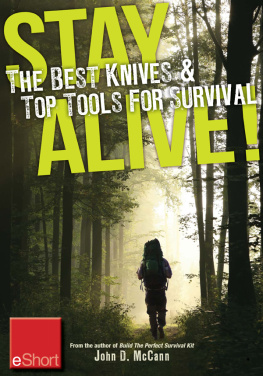Stay Alive: Signaling for Help
Learn how to use natural and manmade devices to let help know where you are.
By John D. McCann
Another important activity in a survival situation is to signal people who might be trying to locate you. Most successful rescues occur because the person is able to assist in their own recovery. Rescue efforts that fail are often because the survivor lacks the knowledge and/or ability to signal for help.
The first step toward a successful rescue occurs before you leave home: let someone know where you are going and when you will be back. Obviously, in some situations this isnt possible, but most of the time you can. If you do so, you know that if you dont return at an expected time, someone will be looking for you and have a general idea of where you might be.
Signaling is a survival skill that you should take seriously. You should be equipped and skilled in the event your trip takes a turn for the worse and you need rescuers to find you. Always have the ability to signal by various means depending on the environment, weather, and situation.
The glass used in Vector 1 mirrors is virtually distortion-free, allowing the reflected sunlight to travel 25 or more miles.
Signal mirror
Every survival kit should have a survival mirror. It is the most underrated and valuable daytime means of signaling. There are various shapes and sizes, and as usual, your choice will depend on the size of your kit.
Glass signal mirrors are the heaviest, but provide the best reflection available. The finest I have found are manufactured by Vector 1, Inc. Mirrors like these were originally developed for the U.S. Air Force for use by downed pilots and their crew. The Vector 1, Inc. Air Force-type signal mirror is one of the leading survival signal mirrors on the market today, and is made of 1/4-inch laminated, shatter-resistant glass.
The unique feature of the Vector 1 Air Force signal mirror is the center viewing hole and sight targeting retro-reflective grid. This special feature allows the lost party to direct up to six million candlepower of reflected sunlight onto the rescue target with pinpoint accuracy.
The Japanese glass used in Vector 1 mirrors is virtually distortion-free, allowing the reflected sunlight to travel 25 or more miles. This is two to four times further than the light travel from metal or acrylic mirrors. Each mirror has a reinforced lanyard hole and comes in a protective foam pouch. Use directions are printed on the back of the mirror. They come in two sizes, 2x3 inches and 3x5 inches. I carry one of the 2x3s in a specific pouch mounted to the shoulder strap of my smaller packs, and a 3x5 in my larger packs. Survival Resources makes custom padded cases for each of these mirrors, which help to protect the glass mirrors.
A signal mirror is the most underrated and valuable means of signaling during daytime.
Another good signal mirror made by Vector 1, Inc., called the Vector 1, measures 2x3 inches and fits in all but the smallest kit. The Vector 1 signal mirror was developed to offer the best of both worlds in signal mirror technology. The reflective mirror is glass, providing superior flash distance (up to 25 miles), encased in durable and break resistant acrylic. The sight grid offers a retro-reflective mesh aimer providing truly accurate aiming ability. The acrylic case is waterproof, floats and provides a lanyard hole. Use directions are printed on the backside of the mirror. It weighs one ounce.
Another good signal mirror is the Rescue-Flash Signal Mirror manufactured by Adventure Medical Kits. It is made of durable LEXAN polycarbonate with a mil-spec retro-reflective aiming aid (which is the grid produced by Vector 1, Inc.) for one handed use. Visible to over 20 miles, it has instructions printed on the back. The mirror is covered by a protective cover to prevent scratches while stored in a survival kit. It has a lanyard hole and measures 2x3x1/8 inches and weighs 0.7 ounce.
Another mirror, super light but not in the same class as the mirrors above, is the Featherweight Mirror manufactured by Sun Company. Larger than the Vector 1 and Rescue-Flash, it measures 4-1/4x3-1/8 inches and is only 1/32-inch thick. It is of shatterproof metal construction, is bendable and can be slid into tight places in a kit. It also has a sighting and lanyard hole.
The retro-reflective aiming grid is a screen mesh material installed at the center viewing hole of a signal mirror
Retro-reflective grid
Without getting too technical, the retro-reflective aiming grid is a screen mesh material installed at the center viewing hole of a signal mirror. This screen mesh grid is coated with spherical beads of high angularity, which causes the light striking them to reflect directly back in the same direction, as opposed to another angle. This is known as retro-reflectivity. This is the same principle as the light from your headlights that hits street signs at night. The light, instead of reflecting off at another angle, reflects straight back at you. Anyway, because of the mesh screen, light from the suns rays are free to pass through. As you look through the grid and the sun strikes it, you see a burst of light in the viewer. As you move this burst of light to your target, the light reflected off the mirror is directed straight to the target. This allows a signal mirror with a retro-reflective grid to be aimed very accurately.

The light burst observed through the aiming indicator is not the sun, but a reflection on the grid from the sun. As you manipulate the mirror and turn it towards your target, in this case a tree, the reflected light from the sun on the surface of the mirror is being directed exactly where the light burst is aimed.
When using a mirror with a retro-reflective aiming grid, first reflect light from the mirror onto a nearby surface. Slowly bring the mirror to eye level and look through the sighting hole. You will see a bright light spot on the aiming grid. This is your aiming indicator. Hold the mirror close to the eye and slowly turn or tilt the mirror until the bright light spot is on the object you want to signal. Slightly tilt the mirror back and forth and the flash from the mirror will be aimed directly at the target. Make sure you keep the bright light spot on the target as you tilt the mirror, in order to keep the flash on the target.
Use two fingers to aim a signal mirror. Reflect the light off the mirror onto your fingers. Direct the reflected light between the V made by the fingers. If the target is between your fingers, it will see the flash.

